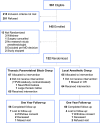Reducing persistent postoperative pain and disability 1 year after breast cancer surgery: a randomized, controlled trial comparing thoracic paravertebral block to local anesthetic infiltration
- PMID: 24165901
- PMCID: PMC3933756
- DOI: 10.1245/s10434-013-3334-6
Reducing persistent postoperative pain and disability 1 year after breast cancer surgery: a randomized, controlled trial comparing thoracic paravertebral block to local anesthetic infiltration
Abstract
Background: The objective of this study was to compare the effect of thoracic paravertebral block (TPVB) and local anesthetic (LA) on persistent postoperative pain (PPP) 1 year following breast cancer surgery. Secondary objectives were to compare the effect on arm morbidity and quality of life.
Methods: Women scheduled for elective breast cancer surgery were randomly assigned to either TPVB or LA followed by general anesthesia. An NRS value of >3 at rest or with movement 1 year following surgery defined PPP. Blinded interim analysis suggested rates of PPP much lower than anticipated, making detection of the specified 20 % absolute reduction in the primary outcome impossible. Recruitment was stopped, and all enrolled patients were followed to 1 year.
Results: A total of 145 participants were recruited; 65 were randomized to TPVB and 64 to LA. Groups were similar with respect to demographic and treatment characteristics. Only 9 patients (8 %; 95 % CI 4-14 %) met criteria for PPP 1 year following surgery; 5 were in the TPVB and 4 in the LA group. Brief Pain Inventory severity and interference scores were low in both groups. Arm morbidity and quality of life were similar in both groups. The 9 patients with PPP reported shoulder-arm morbidity and reduced quality of life.
Conclusions: This study reports a low incidence of chronic pain 1 year following major breast cancer surgery. Although PPP was uncommon at 1 year, it had a large impact on the affected patients' arm morbidity and quality of life.
Figures
Similar articles
-
Single-injection thoracic paravertebral block and postoperative analgesia after mastectomy: a retrospective cohort study.J Clin Anesth. 2015 Aug;27(5):371-4. doi: 10.1016/j.jclinane.2015.04.003. Epub 2015 May 6. J Clin Anesth. 2015. PMID: 25957529 Free PMC article.
-
Efficacy of pectoral nerve block type II versus thoracic paravertebral block for analgesia in breast cancer surgery.Klin Onkol. 2020 Summer;33(4):296-301. doi: 10.14735/amko2020296. Klin Onkol. 2020. PMID: 32894959 English.
-
[The effect of thoracic paravertebral block on seroma reduction in breast surgery - a randomized controlled trial].Braz J Anesthesiol. 2020 May-Jun;70(3):215-219. doi: 10.1016/j.bjan.2019.12.015. Epub 2020 May 17. Braz J Anesthesiol. 2020. PMID: 32536425 Free PMC article. Clinical Trial.
-
Paravertebral anaesthesia with or without sedation versus general anaesthesia for women undergoing breast cancer surgery.Cochrane Database Syst Rev. 2021 Feb 25;2(2):CD012968. doi: 10.1002/14651858.CD012968.pub2. Cochrane Database Syst Rev. 2021. PMID: 33629404 Free PMC article.
-
Paravertebral block: new benefits from an old procedure.Curr Opin Anaesthesiol. 2007 Aug;20(4):316-8. doi: 10.1097/ACO.0b013e328166780e. Curr Opin Anaesthesiol. 2007. PMID: 17620838 Review.
Cited by
-
Evidence-Based Guideline on the Prevention and Management of Perioperative Pain for Breast Cancer Peoples in a Low-Resource Setting: A Systematic Review Article.Anesthesiol Res Pract. 2023 Nov 3;2023:5668399. doi: 10.1155/2023/5668399. eCollection 2023. Anesthesiol Res Pract. 2023. PMID: 37953883 Free PMC article. Review.
-
Risk factors for long-term arm morbidities following breast cancer treatments: A systematic review.Oncotarget. 2023 Dec 1;14:921-942. doi: 10.18632/oncotarget.28539. Oncotarget. 2023. PMID: 38039404 Free PMC article.
-
C-reactive Protein Level on Postoperative Day One is Associated with Chronic Postsurgical Pain After Mastectomy.Anesth Pain Med. 2018 Aug 7;8(4):e79331. doi: 10.5812/aapm.79331. eCollection 2018 Aug. Anesth Pain Med. 2018. PMID: 30250822 Free PMC article.
-
Comparative Study Between Conventional Landmark Versus Ultrasound-Guided Paravertebral Block in Patients Undergoing Laparoscopic Cholecystectomy: A Randomized Controlled Study.Cureus. 2023 Mar 27;15(3):e36768. doi: 10.7759/cureus.36768. eCollection 2023 Mar. Cureus. 2023. PMID: 37123682 Free PMC article.
-
Post-Breast Surgery Pain Syndrome: Shifting a Surgical Paradigm.Plast Reconstr Surg Glob Open. 2021 Jul 22;9(7):e3720. doi: 10.1097/GOX.0000000000003720. eCollection 2021 Jul. Plast Reconstr Surg Glob Open. 2021. PMID: 34316427 Free PMC article.
References
-
- Canadian Cancer Society’s Steering Committee on Cancer Statistics . Canadian Cancer Statistics 2012. Toronto, ON: Canadian Cancer Society; 2012.
Publication types
MeSH terms
Substances
LinkOut - more resources
Full Text Sources
Other Literature Sources
Medical
Miscellaneous


